This post is all about YouTube for agencies. After all, YouTube is the second-largest search engine and an effective way to generate organic traffic for your business. But why is it so difficult for agencies to convert leads on YouTube?
There’s a secret to YouTube marketing, and that will result in creating better video content and a stronger strategy. Here’s your YouTube for agencies guide and when YouTube marketing services are a better option.
Key Highlights of YouTube for Agencies
- Agencies run into similar challenges when marketing on YouTube, such as measuring direct attribution, struggling to increase customer acquisition, long sales cycles, and reliance on other marketing platforms.
- YouTube marketing is still beneficial for agencies because it can improve brand awareness, grow organic traffic, attract a global audience, and it’s easy to repurpose video content on multiple platforms.
- Some of the best YouTube marketing strategies for agencies include targeting companies that already value video content, optimizing for video SEO and SEvO, measuring referral traffic, optimizing for direct brand searches, leveraging case studies, addressing customer pain points in videos, maintaining branding, utilizing playlists, implementing lead magnets and CTAs, optimizing for the sales funnel, and repurposing video content.
- Don’t forget to optimize your YouTube strategy for a global audience by localizing content, repurposing videos for different countries, and using YouTube for global account-based marketing.
TABLE OF CONTENTS:
The Challenges of Measuring ROI in YouTube Marketing
Many agencies struggle on YouTube because they encounter the same hurdles, such as intense competition and releasing new content. There are also more significant challenges that can prevent an agency from converting leads on YouTube.
Direct Attribution
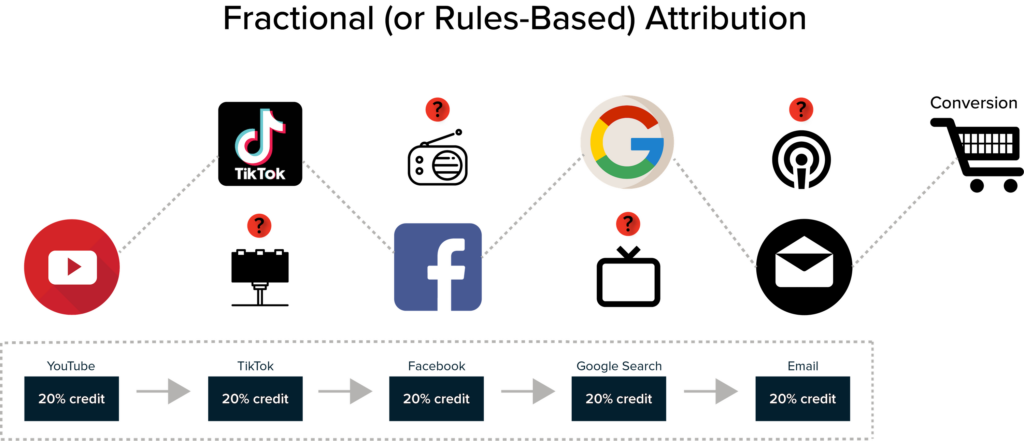
Source: OptiMine
While there are reports in YouTube Studio that show vital metrics, such as viewers, subscribers, and impressions, it’s still challenging to measure the direct impact that these KPIs have on sales. Unlike pay-per-click (PPC) advertising, where clicks and conversions can be directly tracked, YouTube operates more like SEO.
Videos contribute to brand awareness and organic discovery over time, along with other platforms like TikTok and Facebook, rather than delivering immediate results. This makes proving the direct impact of video marketing on revenue more complex without a strategy like multi-touch attribution.
Resistance from B2B and SaaS Companies
Many B2B and SaaS companies remain hesitant about YouTube because they haven’t yet experienced measurable success with the platform. YouTube videos may not have much of an impact on customer acquisition. Plus, their marketing teams may be more comfortable with performance-driven channels such as LinkedIn ads, Google Ads, or content marketing through blogging rather than YouTube.
Long Sales Cycles
Leads take extensive time to convert for agencies, SaaS, and other enterprise niches. Sales cycles often extend over months or even years. YouTube videos may play a critical role in brand familiarity, trust-building, and nurturing leads, but their impact is difficult to isolate from other marketing and sales activities.
Comparison to Other Marketing Channels
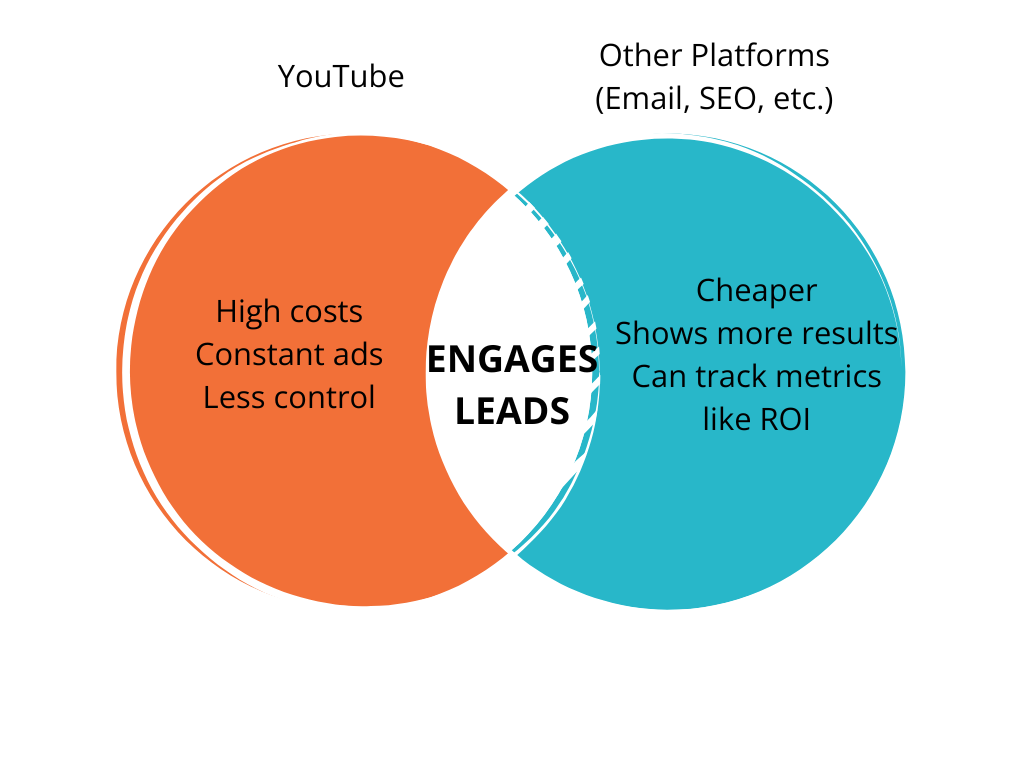
Video marketing comes with high costs and constant ads bog the platform. Marketing teams accustomed to other channels may find it hard to justify the investment in YouTube, especially when other platforms are cheaper, and marketers have more control over them.
Unlike YouTube marketing, email, PPC, and SEO show more results with agencies. These businesses can track ROI more precisely, while YouTube requires a more holistic view of attribution and engagement.
Why YouTube Marketing Is Still Worth It for Agencies
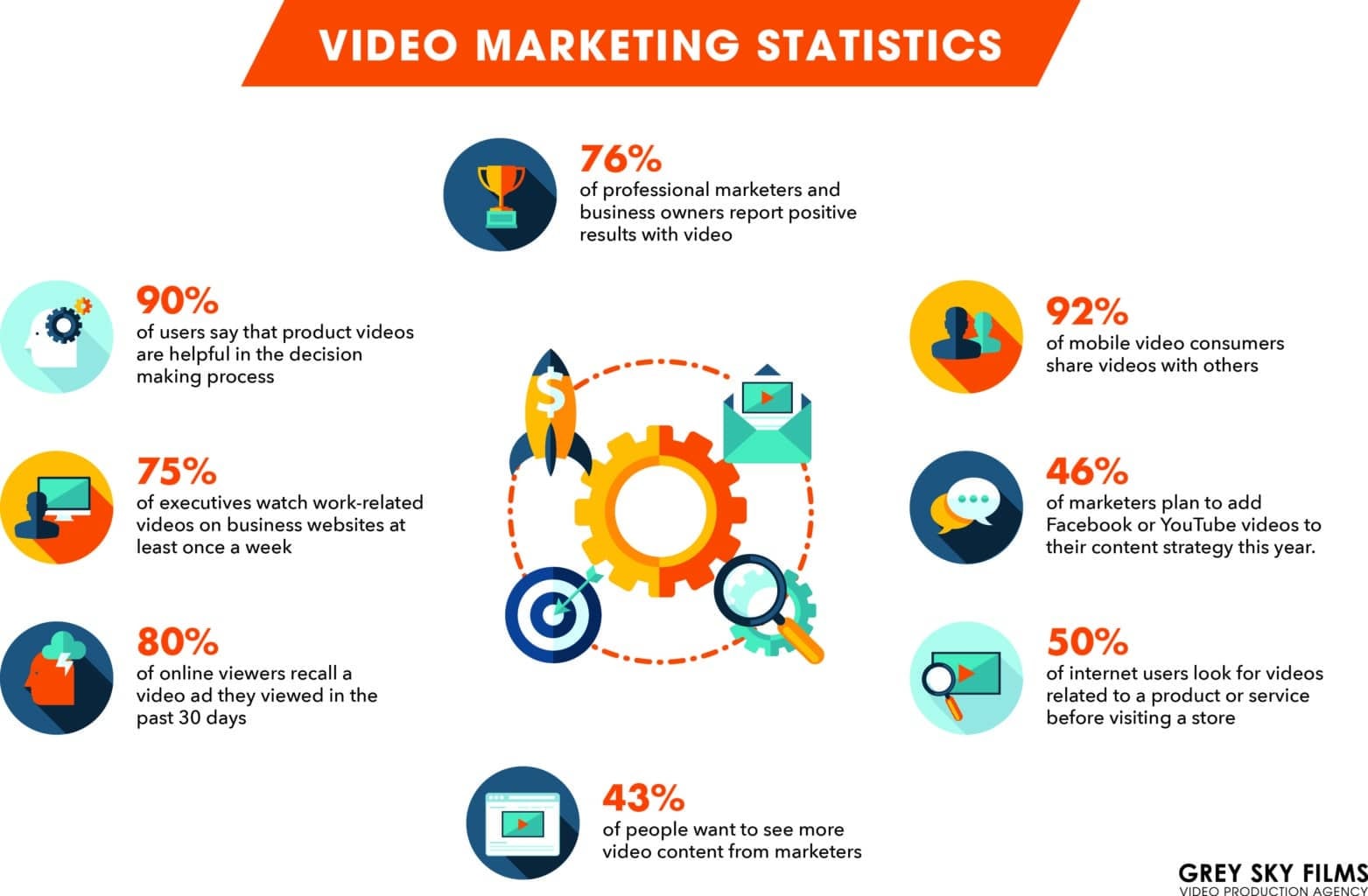
Source: Review Zone
While proving direct ROI remains challenging, YouTube’s importance in marketing is undeniable. Businesses that invest in YouTube early stand to gain a significant competitive advantage, much like those that embraced SEO in the early 2000s.
The key is for agencies to focus on brand visibility, customer engagement, and long-term lead generation. This way, companies can unlock the true potential of YouTube marketing.
Here are other advantages of YouTube marketing for agencies:
- Improved brand awareness: Video marketing is better for a TOFU strategy since YouTube is an excellent way to boost brand awareness.
- Generates more traffic: YouTube has 2.94 million active users, offering impressive traffic potential.
- Attract a global audience: The USA doesn’t have the largest percentage of YouTube viewers. India takes the lead with 467 million viewers! This means that agencies can use YouTube to increase their global audience.
- Can combine with other marketing strategies: YouTube is a versatile platform. Agencies can upload on YouTube to boost SEO and SEvO performance. YouTube videos are also perfect for repurposing on various social media platforms.
Strategies to Prove and Measure ROI on YouTube
YouTube has downsides, but agencies can still measure an impressive ROI on the world’s largest video platform.
Focus on Attracting Leads That Already Value Video Content
All marketing agencies know they must collect data and research to understand their audience. This is necessary when creating a YouTube marketing strategy. Part of the process is understanding the businesses and niches that benefit most from YouTube marketing.
Rather than spending resources convincing skeptical clients, prioritize accounts that consume video content. Plus, businesses that value content marketing, particularly those using SEO and thought leadership strategies, are more likely to understand YouTube’s long-term benefits.
Show the Search Engine Impact
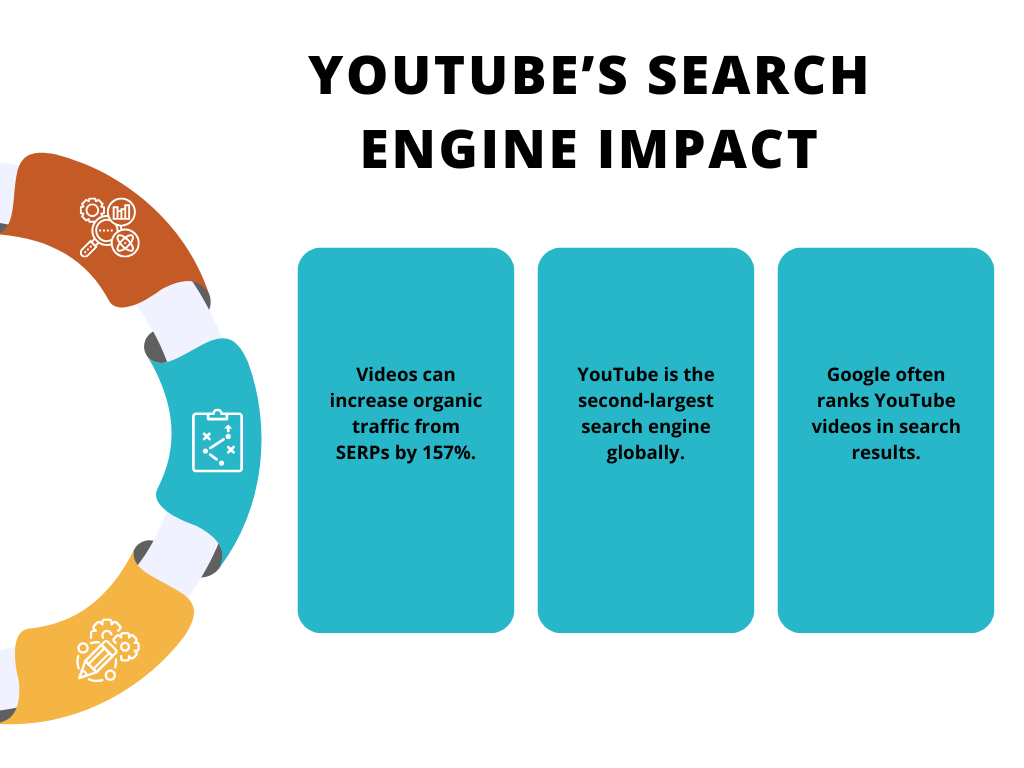
Videos can increase organic traffic from SERPs by 157%. That’s because YouTube is the second-largest search engine globally, and Google often ranks YouTube videos in search results. Demonstrating how videos rank for competitive keywords can help businesses understand YouTube’s role in organic traffic growth.
Use YouTube Referral Traffic Data
Google Analytics can track how many website visitors come from YouTube. Go to Google Analytics and navigate to Acquisition > All Traffic Sources > Referrals. Google Analytics will display YouTube website referrals along with other sources.
For best results, set up UTM parameters and track referral traffic. This way, agencies can provide concrete data on how YouTube contributes to inbound marketing efforts.
Measure Direct Brand Searches

Source: Ahrefs
Branded searches are when users search a company’s name, proving that audiences are interested in your business. This also tells Google you’re a trustworthy business, further improving SERP performance and boosting brand awareness.
A strong YouTube presence leads to increased branded searches on Google and YouTube itself. Tracking search volume increases for a brand name before and after launching a YouTube strategy can provide evidence of its impact.
Leverage Case Studies from Successful Companies
Using case studies of Fortune 500 and SaaS giants that have leveraged YouTube successfully can help persuade decision-makers. For example, Snowflake, Salesforce, and HubSpot have used YouTube to build credibility and drive customer acquisition.
Address Customer Pain Points to Reduce Churn
Do your customers face recurring issues? YouTube content can be used not only for lead generation but also for customer retention. Educational and troubleshooting videos help customers maximize product usage, reducing churn and increasing lifetime value (LTV).
Have Consistent Branding
Your brand is something that clients and accounts will recognize, so apply all branding to your videos. Always have your logo on every video, and use consistent branding in your channel description, color scheme, title cards, thumbnails, and messaging. Your videos should also have consistent intros and CTAs.
Create Playlists
Once you start uploading more videos, organize similar content into different playlists. Playlists encourage viewers to watch more videos; YouTube has an autoplay feature on playlists, a great way to boost traffic and engagement rates. Playlists also allow your audience to deep dive into the topics you’re covering.
What are some good playlist suggestions for agencies? Success stories, testimonials, tutorials, and product demos are all effective playlist types relevant to agencies in all industries.
Implement Lead Magnets and Call-to-Actions (CTAs)
YouTube videos can drive direct conversions through strategically placed lead magnets, such as free trials, webinars, or gated content. Using unique tracking links in video descriptions allows for conversions from YouTube.
Adopt Sales Funnel Targeting
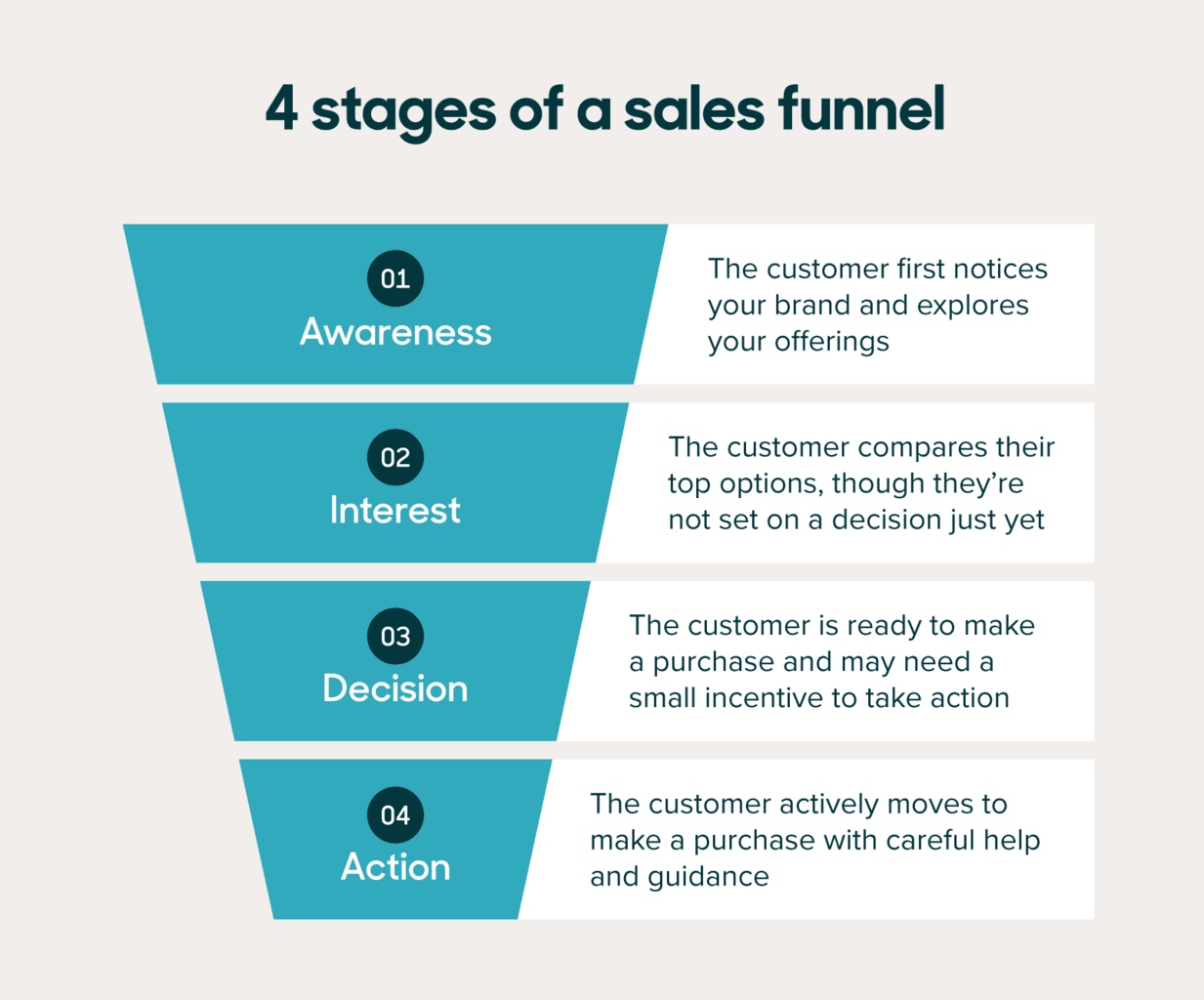
Source: Zendesk
The average sales funnel has four stages: awareness, interest, decision, and action. Marketers must tailor their messaging to each step to ensure their target audience continues down the funnel.
As a result, businesses should focus on more than just last-click attribution models when marketing on YouTube. To understand the different sales funnel stages and how to target the audiences in each step, use CRM tools like HubSpot, Salesforce, or Google Analytics 4 (GA4). Have multiple lead magnets that touch on different stages in the buying journey.
Repurpose YouTube Videos
Since other social media platforms favor video content, repurpose your YouTube videos on various platforms. Popular video types vary on each platform. Facebook favors carousel-type videos, while polished B2B videos with a compelling message dominate on LinkedIn.
Video repurposing on TikTok is more flexible since several video types dominate that platform. However, a simple way to go viral on TikTok is by following trends and creating videos aligning with trends.
In addition, all agencies should embed their YouTube videos into their blog and newsletters. Plus, don’t forget to take advantage of YouTube Shorts. YouTube Shorts have a 5.91% engagement rate, and all you need to do is trim down your existing videos.
Integrating YouTube Into a Global Marketing Strategy
For companies targeting international markets, YouTube offers a cost-effective way to scale brand awareness and engagement globally. Here’s how:
- Localized content strategy: Creating region-specific content in multiple languages can enhance engagement in key markets.
- Repurposing video content for various regions: Webinars, conference talks, and product demos can be repurposed by translating them, organizing countries and languages by playlists, and reposting them on region-specific platforms.
- Using YouTube for global ABM: Video content is engaging and persuasive, better for attracting more prospective international accounts.
YouTube for Agencies: We Can Unlock Your Potential
YouTube for agencies can be beneficial. However, proving ROI on YouTube marketing remains a challenge. Agencies struggle with hurdles when marketing on YouTube, but businesses that invest in the platform stand to gain significant long-term benefits.
Agencies can have a successful YouTube marketing strategy by focusing on search rankings, brand engagement, referral traffic, and lead generation strategies. Even agencies with a long sales cycle, such as SaaS businesses, will have a competitive advantage on YouTube.
Has your agency made YouTube content and invested in ads but didn’t gain the return you expected? Single Grain Marketing understands that YouTube is an important channel. As a YouTube marketing agency, we offer tailored services to agencies, such as SaaS, e-commerce, blockchain, and more.
If you’re ready to level up your YouTube marketing strategy, Single Grain’s video marketing experts can help!👇
Related Video
For more insights and lessons about marketing, check out our Marketing School podcast on YouTube.
FAQ About YouTube for Agencies
-
What is YouTube marketing?
YouTube marketing campaigns promote a brand, product, or service through video content. It includes both organic and paid strategies to reach and engage an audience.
-
Is video marketing still important in 2025?
Video marketing is more important than ever in 2025 as audiences prefer video content over text and static images.
YouTube is still the second-largest search engine, even with AI’s influence. Audiences still retain more information when watching a video. Gen Z especially watches more videos than any other generation.
Even beyond YouTube, social media platforms favor video content over other types. Statistics support video marketing; for example, marketers still say video generates a good ROI. AI and machine learning have also made creating high-quality videos easier, including ones with personalized messaging.
-
Is YouTube marketing expensive for agencies?
YouTube marketing costs can vary widely depending on factors like your targeting, ad format, and competition in your industry.
For example, YouTube video advertising can cost $0.01-$0.30 per view. And if you hire YouTube advertising services, these expenses increase even more. While organic video content is more affordable than ads, agencies must still invest in high-quality video production.
-
How can agencies promote their YouTube channel and videos?
Agencies can promote their YouTube channel and videos using organic strategies, paid ads, and cross-promotion. Fortunately, YouTube videos rank well on SEO, so agencies can get cross-channel benefits without extra effort.
-
Are YouTube ads or video content better at driving conversions?
Both organic and paid YouTube strategies can increase conversions, but both have pros and cons. YouTube ads are better for instant reach, but the costs can increase. Organic video content increases traffic and brand awareness over time, but it takes longer to build an engaged audience.






